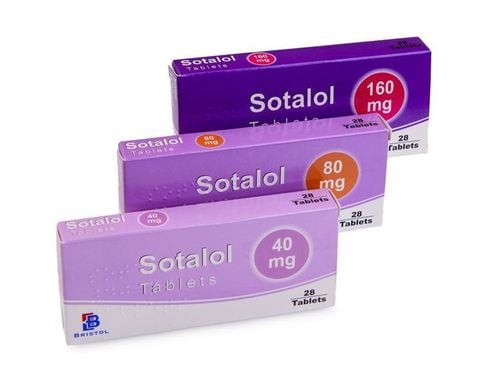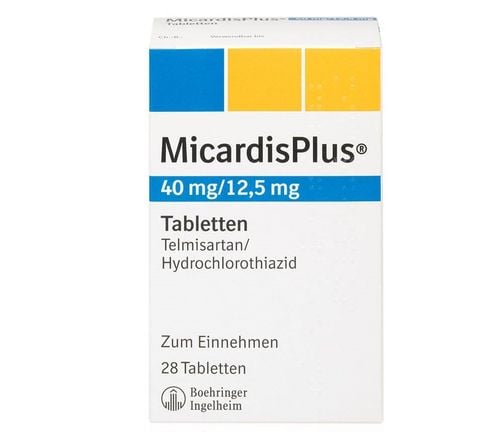This is an automatically translated article.
Cancetil Plus is made in the form of tablets, with the main ingredients being Candesartan cilexetil and Hydrochlorothiazide. Drugs used in the treatment of patients with high blood pressure
1. What is Cancetil Plus?
The composition of Cancetil Plus includes Candesartan cilexetil 16mg and Hydrochlorothiazide 12.5mg.In which, Candesartan cilexetil is an angiotensin II receptor blocker. Candesartan cilexetil is a prodrug, with little effect until hydrogenated during gastrointestinal absorption, to form Candesartan (the active substance). Candesartan treats hypertension by blocking the AT1 receptor of angiotensin II. And Hydrochlorothiazide is a thiazide diuretic, which works to increase the excretion of sodium chloride and accompanying water (thanks to the mechanism of inhibiting the reabsorption of sodium and chloride ions in the distal tubule). Hydrochlorothiazide has antihypertensive effects due to its ability to reduce plasma and extracellular fluid volume associated with sodium diuresis. In addition, thiazides have a moderate diuretic effect.
Indications for the use of Cancetil Plus:
Treatment of hypertension: The combination form is not recommended for initial treatment. Contraindications to using Cancetil Plus:
Patients with hypersensitivity to Candesartan, Hydrochlorothiazide, other Sulfonamide derivatives, other ingredients of the drug; People with gout, anuria, hyperuricemia, hypercalcemia, Addison's disease; Patients with severe liver failure, cholestasis, severe renal failure; the second and third trimesters of pregnancy; Combination with Aliskiren in diabetic patients.
2. Instructions on how to take Cancetil Plus
Usage: Orally.
Dosage: The recommended starting dose is 1 tablet/day in patients who are not volume depleted. The dose can be increased to a maximum of 2 tablets/day. Patients take the drug with food or without food, it is possible to combine the drug with other antihypertensive drugs.
Note on dosage:
Hydrochlorothiazide is effective at doses of 12.5 - 50mg/time/day; Dosage of Cancetil Plus should be adjusted based on clinical efficacy. The maximum antihypertensive effect (with any dose) can be achieved after 4 weeks of using that dose; Do not use Cancetil Plus if creatinine clearance (ClCr) is less than 30ml/min; Patients with moderate hepatic impairment: Initiation of therapy is not recommended because an adequate starting dose of Candesartan of 8 mg cannot be achieved; To reduce dose-related side effects, Cancetil Plus should only be used in combination if the desired effect is not achieved when used alone. It is possible to combine drugs instead of adjusting the dose of each ingredient. Besides, symptoms of overdose of Candesartan are usually: Dizziness, low blood pressure, tachycardia or bradycardia. Common symptoms of hydrochlorothiazide overdose are electrolyte depletion (hyponatremia, hypokalemia, hypochloremia) and dehydration due to excessive diuresis. If used with digitalis, hypokalemia can cause arrhythmias.
When managing an overdose of Cancetil Plus, consideration should be given to the possibility of multiple drug overdoses, drug interactions, and changes in the pharmacokinetics of the patient. If symptomatic hypotension occurs, supportive measures should be instituted.
3. Side effects of the drug Cancetil Plus
When using Cancetil Plus, patients may experience some side effects such as:
Whole body: Fatigue, weakness, chest pain, back pain, peripheral edema, flu-like symptoms, dizziness, dizziness facial, paresthesia, hypoesthesia, anxiety, insomnia, depression; Gastrointestinal: Abdominal pain, nausea, dyspepsia, diarrhea, vomiting, gastroenteritis, jaundice, pancreatitis, salivary gland inflammation, constipation, cramps, loss of appetite, stomach irritation, inflammation liver, abnormal liver function, increased transaminases; Respiratory: Sinusitis, pharyngitis, bronchitis, rhinitis, cough, difficulty breathing; Musculoskeletal - Joint: Myalgia, arthralgia, arthritis, joint damage, sciatica, leg cramps, muscle spasms, rhabdomyolysis (rare); Metabolic: Hyperglycemia, hyponatremia and potassium, increased uric acid, increased BUN and creatine phosphokinase; Cardiovascular: Tachycardia, ventricular extrasystoles, angina, bradycardia, myocardial infarction, angioedema, abnormal ECG; Skin: Sweating, eczema, pruritus, dermatitis, urticaria, rash, erythema multiforme, exfoliative dermatitis, alopecia, toxic epidermal necrolysis, Stevens-Johnson syndrome; Hematology: Leukopenia, neutropenia, agranulocytosis, epistaxis, aplastic anemia, thrombocytopenia, hemolytic anemia; Immunity: Viral infections, infections; Hypersensitivity: Vasculitis, anaphylaxis, respiratory failure (pneumonia, pulmonary edema), urticaria, purpura, photosensitivity; Other: Tinnitus, conjunctivitis, transient blurred vision, yellow tint, impotence. When experiencing side effects of Cancetil Plus, the patient should immediately notify the doctor to know the next steps to handle accordingly.
4. Notes when using Cancetil Plus
Some notes for patients to remember before and while using Cancetil Plus:
Patients may experience symptomatic hypotension, especially when volume or salt is reduced due to dietary deficiency. salt, dialysis, prolonged use of diuretics, diarrhea or vomiting. At this point, the dose of Cancetil Plus should be reduced or the volume restored. It is recommended to restore hypovolaemia or salt before treating the disease; In patients with heart failure, Cancetil Plus may cause excessive hypotension, leading to azotemia, oliguria, acute renal failure and (rarely) death. Treatment should be initiated under close medical supervision, especially during the first 2 weeks of dosing and each time the dose is increased; Monitor renal function periodically during treatment with Cancetil Plus. People whose renal function depends in part on the activity of the renin-angiotensin system (RAS) such as renal artery stenosis, severe heart failure, chronic kidney disease, volume depletion, may be at risk for oliguria. progressive azotemia, acute renal failure, etc. Continuation or discontinuation of Cancetil Plus should be considered in patients with clinically significant renal impairment; Candesartan in Cancetil Plus can cause hyperkalemia. Hydrochlorothiazide may cause hyponatremia and hypokalemia. Serum electrolytes should be monitored periodically, avoid co-administration of this drug with potassium supplements or potassium-containing salts; Hydrochlorothiazide can lead to acute transient myopia, acute angle-closure glaucoma. Common symptoms include eye pain, sudden loss of vision (usually occurring at the beginning of the drug, within hours or weeks). If the above symptoms occur, the patient should stop taking Hydrochlorothiazide as soon as possible; Hypersensitivity reactions to Hydrochlorothiazide may occur, especially in patients with a history of allergy or bronchial asthma; Hydrochlorothiazide may alter glucose tolerance, increase cholesterol and blood triglycerides. The drug can also increase blood uric acid by reducing clearance, can cause increased uric acid more, leading to gout in susceptible patients; Thiazides reduce renal calcium excretion, possibly causing mild hypercalcemia. Therefore, avoid taking Cancetil Plus for patients with hypercalcemia; Thiazides can trigger and aggravate systemic lupus erythematosus, so patients should be cautious; There is a risk of dizziness when using Cancetil Plus. Therefore, caution should be exercised when driving or operating machinery; Candesartan and Hydrochlorothiazide are not recommended during the first trimester of pregnancy. Candesartan is contraindicated in the second and third trimesters of pregnancy. When pregnancy is detected, the drug should be stopped immediately, using alternative treatment if possible; Cancetil Plus should not be used in nursing mothers. Discontinuation of the drug or cessation of breastfeeding should be considered (depending on the importance of the drug to the mother).
5. Cancetil Plus drug interactions
Drug interactions with Candesartan cilexetil and Hydrochlorothiazide:
Concomitant use of Cancetil Plus with non-steroidal anti-inflammatory drugs (including selective COX-2 inhibitors) may reduce the antihypertensive effect, decrease renal function reversible (including acute renal failure), especially in the elderly, volume depletion, impaired renal function; Concomitant use of Cancetil Plus with Lithium increases the toxicity of Lithium (Candesartan increases the serum concentration of Lithium Hydrochlorothiazide reduces the clearance of Lithium); Concomitant use of Cancetil Plus with other antihypertensive agents causes additive effects. Interactions with Candesartan cilexetil:
Concomitant use of Candesartan cilexetil with angiotensin receptor blockers, angiotensin converting enzyme inhibitors, aliskiren increases the risk of hypotension, hyperkalemia, changes in renal function (including acute renal failure). . Blood pressure, electrolytes and renal function should be closely monitored when combining drugs that affect renin-angiotensin; Candesartan cilexetil can be combined with beta-blockers, diuretics, digitalis or a combination of these drugs. Do not combine with angiotensin-converting enzyme inhibitors, potassium-sparing diuretics (spironolactone), only after careful assessment of benefits and risks; If Candesartan cilexetil is used concurrently with potassium-sparing diuretics, potassium-containing salt substitutes, potassium supplements, other drugs (heparin) may increase blood potassium; Do not combine Candesartan cilexetil with aliskiren in patients with diabetes, patients with renal failure (GFR < 60 mL/min). Interaction with Hydrochlorothiazide:
Concurrent use of Hydrochlorothiazide with alcohol, narcotics, barbiturates may cause orthostatic hypotension; Concomitant use of Hydrochlorothiazide with oral antidiabetic drugs and insulin should reduce the dose of these drugs; Concomitant use of Hydrochlorothiazide with cholestyramine and colestipol resins may decrease the absorption of Hydrochlorothiazide. Hydrochlorothiazide should be taken at least 4 hours before or 4-6 hours after taking the above preparations; Concomitant use of Hydrochlorothiazide with Corticosteroids, ACTH increases the state of electrolyte depletion (hypokalemia); Concomitant use of Hydrochlorothiazide with cardiac glycosides: Thiazides will lower blood potassium or magnesium, easily causing digitalis-induced arrhythmias; Concomitant use of Hydrochlorothiazide with amines causing hypertension (noradrenalin) reduces the effect of these amines; Concomitant use of Hydrochlorothiazide with a non-depolarizing skeletal muscle relaxant (tubocurarin) increases the effect of these drugs; Concomitant use of Hydrochlorothiazide with drugs for gout: Should adjust the dose of drugs; Concomitant use of Hydrochlorothiazide with calcium salts will increase blood calcium due to decreased excretion; Concomitant use of Hydrochlorothiazide with carbamazepine increases the risk of symptomatic hyponatremia; Other drugs: Beta-blockers, diazoxide (raise blood sugar); amantadine (thiazides increase the risk of side effects from amantadine); anticholinergic drugs such as atropine, biperiden (increases thiazide bioavailability by reducing intestinal motility and decreasing gastric emptying rate); cytotoxic drugs such as cyclophosphamide, methotrexate (decreases renal excretion of drugs and increases myelosuppression). When using Cancetil Plus, the patient should follow all the instructions of the doctor. This helps to improve the treatment effectiveness of the drug, significantly reducing the risk of unexpected incidents and side effects.
Please dial HOTLINE for more information or register for an appointment HERE. Download MyVinmec app to make appointments faster and to manage your bookings easily.













